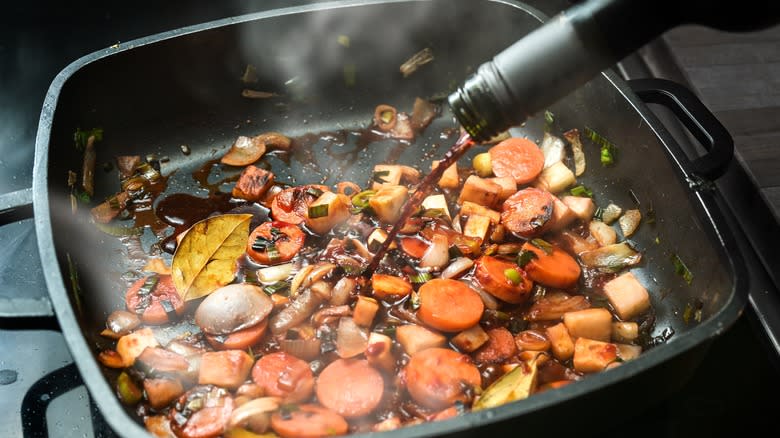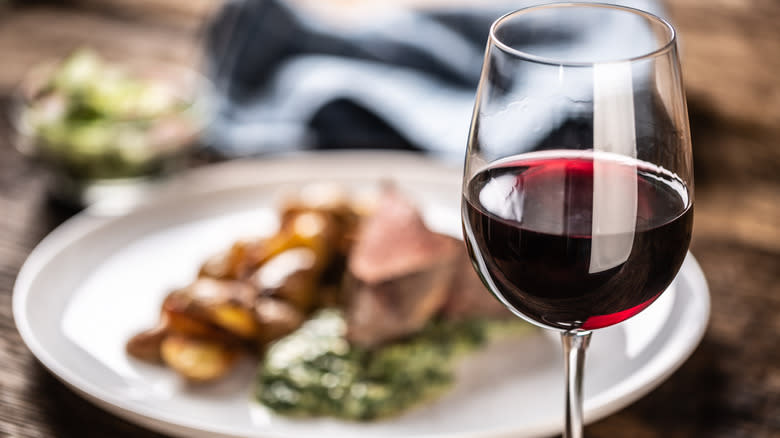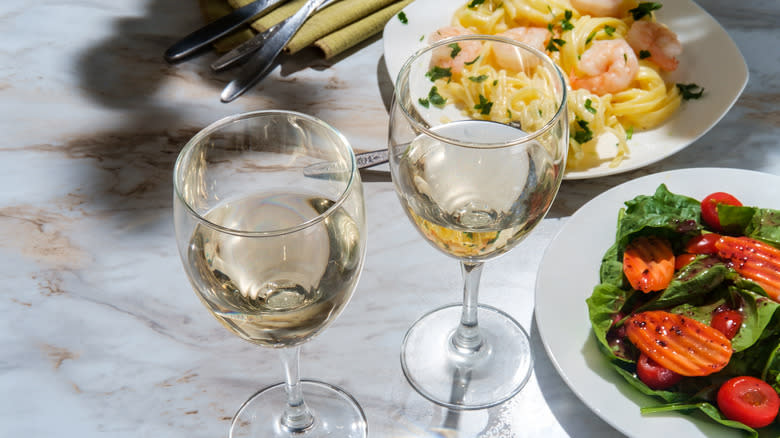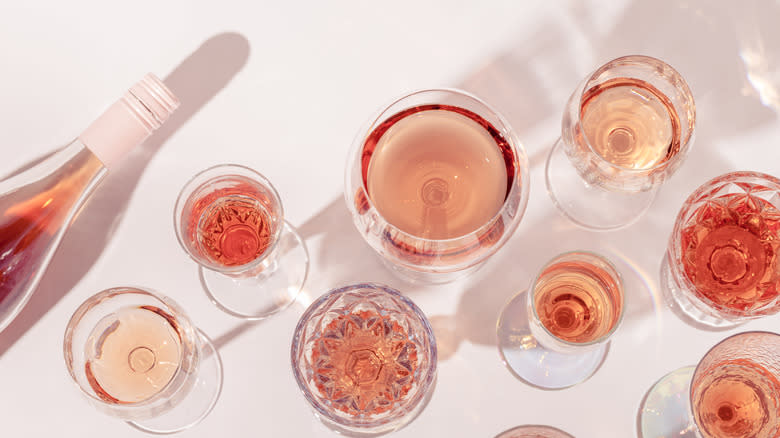How To Choose The Best Wine For Deglazing In Any Recipe

Even if you make your dish with the finest spices and herbs, nothing will ever taste as good as the browned bits of food called fond that get stuck to the bottom of the pan. These remnants are caramelized, and they need a liquid to help remove them from the pan and bring them into the fold of the rest of the dish. Practically any liquid can be used for deglazing, but wine works especially well. The alcohol in it amplifies the flavors in the dish, making them more pronounced. However, not every wine is the best choice for every situation.
To enhance the flavor of the fond (and therefore your recipe) rather than mask it, you'll need the right wine for the job. We spoke to an expert to determine which wines are the best for deglazing in certain recipes. According to Doug Brixton, chef and partner at The Golden Swan, you'll need to look for wines with a low alcohol content before examining other factors. Next, Brixton says to ask yourself why exactly you're adding wine. "To add acidity, sweetness, or start the process of making a sauce?" he questions. Reds and whites are often called upon to deglaze a pan, but don't forget that sparkling wines and rosés make excellent choices, too. All in all, it just depends on what it is you're making.
Read more: The 20 Best Olive Oils For Cooking
Use Red Wine For Heavier Dishes

When using red wine for cooking, you'll have to keep its heady flavor in mind. It can easily overpower a dish if you're not careful, so it'll need something to mirror its depth. "Cooking dark meats such as beef, lamb, or duck, red wine or red port is a good go-to. Especially when using stronger herbs like rosemary, sage, or bay leaves," explains Brixton. Milder herbs will get lost in the sauce; stronger herbs, on the other hand, stay more present, preventing you from having to over-season a dish in order to bring an earthy undertone to the food. "The essence of the herbs will come through the boldness of the wine that much more," notes the chef.
Though you can use any red wine that matches your preference, Brixton has a decisive choice that works with any dish. "Merlot is great," he says. "It reduces well and keeps flavors well in sauces." This varietal tends to be on the dry side, which is often recommended for deglazing since it won't turn too saccharine as the sugars come out. If you do want to balance out the more savory aspects of a dish, it doesn't hurt to use a sweeter wine, though. Brixton occasionally uses port wine, but you can go for something with a medium sweetness, like Zinfandel.
Keep It Simple With White Wine

White wine is crisp and refreshing, best for breezy spring days and warm summer nights. It fits the palate for the weather, too, working best in dishes that are lighter. White wine makes for a great pairing with seafood, something that Doug Brixton says is due to its brightness. However, its usefulness doesn't stop there. "Poultry and also lighter meat such as pork and veal work well with white wine," he comments. Similarly to red wine, the depth of the herbs are also important when choosing what to deglaze with. "If I'm making a dish with light herbs such as chervil, dill, tarragon, or thyme," he says, "a white wine is the choice."
The refined wine comes in handy when you're looking for acidity in a dish, rather than a wine-forward reduction. Its simplicity makes it great for deglazing before building a cream or butter-based sauce. White wine easily tempers heaviness in food without making it taste entirely of pinot grigio. If it tastes like sauvignon blanc, however, that's not entirely bad. The dry wine is Brixton's top choice thanks to its ability to strike the balance between zesty and silky. It won't make dishes taste astringent, so it's perfect for lobster bisque or clam chowder.
Sparkling Wine Is The Flexible Choice For Deglazing

Sparkling wine is usually regarded as a celebratory drink for sipping, but it's truly an underrated deglazing liquid. While its fizziness is great, don't overlook the flavor it brings when cooking. Out of the different types of sparkling wines, this chef prefers one of the more popular varieties for deglazing. "Champagne is versatile for sauce," Brixton says. "Being dry, the flavor of the champagne really comes through." Once the carbonation is gone, out come the nutty, fruity notes of the wine that were lying within the bubbles.
They do enhance sauces, particularly butter sauces as Brixton mentions, but champagne is incredible for seafood as well. Like white wine, it's crisp, embracing the lightness of the cuisine. It's best to stick with something drier, since the sugars become more apparent as the wine cooks down. If you do go with something on the sweeter side of the spectrum, balance it out with seafood that's mild like tilapia or salty like scallops. Sparkling wines can also be used to deglaze a poultry dish, as with champagne chicken. For this, you can lean into the luxuriousness of the recipe by springing for a brut or extra dry sparkling wine. They're not overwhelmingly sweet, but the sugars are still present, bringing out the savory aspects of the food.
Rosé Is All About Balance

A happy medium between red and white, rosé is refreshing, yet still more full-bodied than your average white wine. Its summery tasting notes make it a great deglazing liquid for the same things white wine is used for, though. "Rosé is definitely good in seafood and light meats like pork," Brixton says. Even though rosé is made from red grapes, it doesn't make an equally good stand-in for red vino when deglazing. The pink wine isn't as intense, so it's best when used as an only slightly headier substitute for white wines.
If you want the same acidity from white wine but need something fruitier or sweeter, simply use rosé instead. The wine brings a bright element to savory dishes that can benefit from something more than a tart white wine. Rather than whipping up a fruit glaze for pork or chicken, deglaze the pan with rosé pinot noir. It's medium-bodied, so you'll get a little more depth compared to white wines. Still, it keeps things light with a floral-fruity flavor that plays off the umami taste of meat.
Read the original article on Tasting Table.